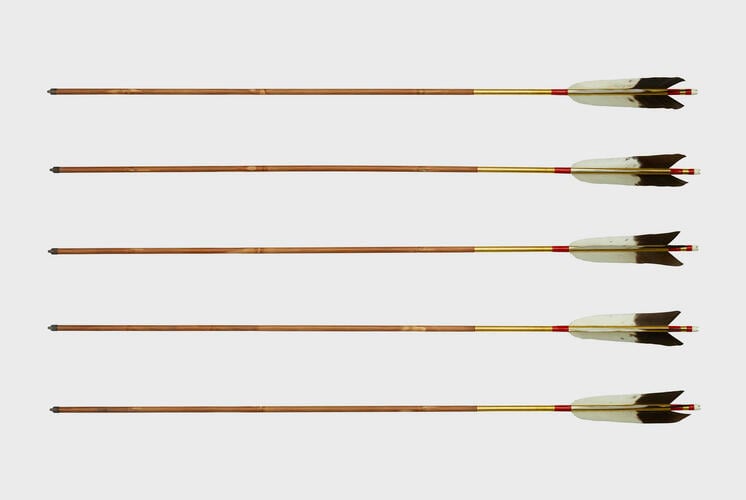-
1 of 253523 objects
Set of arrows (ya) 1912-22
Bamboo, lacquer, wood, ivory, steel, gold foil, feathers | 100 x 4.5 x 4.5 cm (each arrow) (whole object) | RCIN 79915

-
With the advent of peace in Edo-period Japan, the samurai class were instructed to maintain their warrior spirit through continued practice of archery (kyūdō) and the sword (kendō).
Arrows (ya) vary in length according to the physical stature of the user. They have a simple iron or steel tip (ya-no-ne), slightly blunted for use on a straw or paper target, and are traditionally fletched with eagle or hawk feathers. Arrowheads of different shapes were available depending on the arrows’ purpose.
On his final day in Japan in May 1922, Edward, Prince of Wales was entertained by Prince Shimazu Tadashige (1886–1968), son of the last feudal lord of the Satsuma domain. Lunch was served at Prince Shimazu’s villa, followed by an archery demonstration. Afterwards, the Prince of Wales was presented with a complete set for archery practice, including an archer’s glove, arm guard and reel for spare bowstrings, as well as the items here.
This set of twelve arrows is made using yadake bamboo (Pseudosasa Japonica), a tough and narrow bamboo long considered the choice material for Japanese arrow shafts. The black and white feather flights (hane) are likely Steller's sea eagle feather. Each shaft is painted painted gold and red and fitted with a metal arrowhead (ya-no-ne) of standard design, indicating that the arrows are kazuya, for target distance practice. Housed in a red lacquer and glass case.
Text adapted from Japan: Courts and Culture (2020)Provenance
Presented to Edward VIII when Prince of Wales by the Shimadzu family following an archery demonstration at Kagoshima in May 1922. On the same occasion the Prince received a bow (RCIN 79906), a quiver (RCIN 79914), bow case (RCIN 79908), archer's glove (RCIN 719913), arm guard (now missing) and reel for spare bowstrings (now missing).(RA/EVIIIPWH/PS/VISOV/1921-2/INDJAP).
Loaned to Doncaster Museum on 11 February 1931 and returned to the Collection on 6 April 1999. -
Creator(s)
(nationality)Acquirer(s)